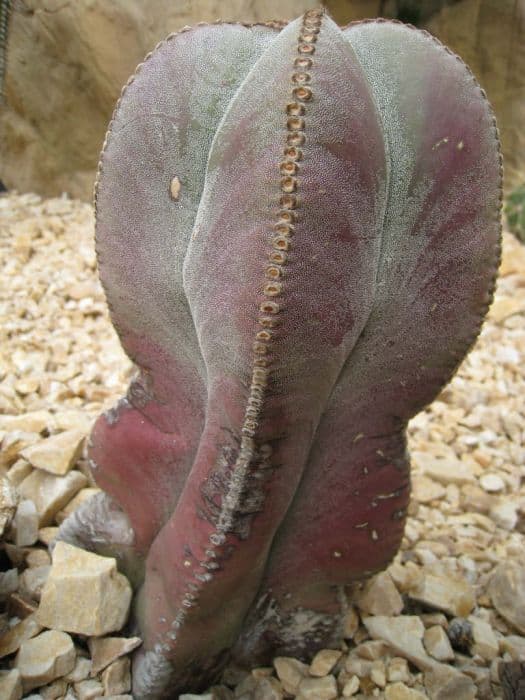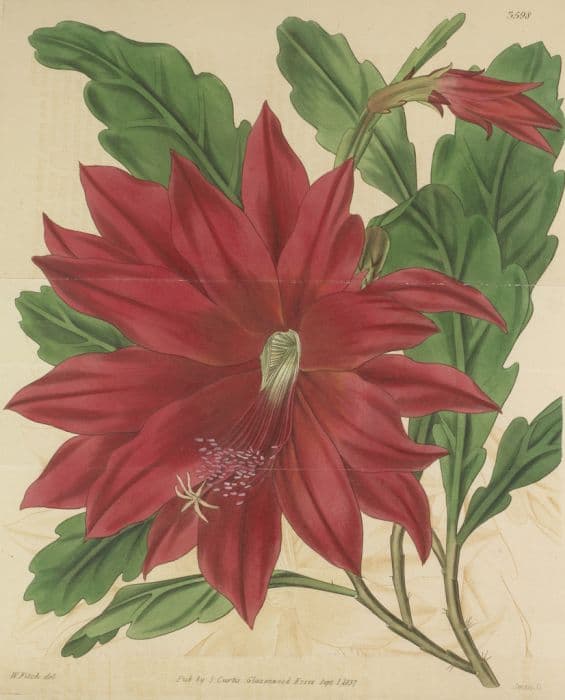Woolly Rhipsalis Rhipsalis floccosa

ABOUT
Rhipsalis floccosa, more often referred to by its common name, the Hairy-fruited Wickerware Cactus, is a unique and eye-catching succulent. This plant is characterized by its cascading growth habit, which makes it an attractive choice for hanging baskets. Its stems are slender and segmented, often displaying a pale green to yellowish hue. These stems tend to grow in a sprawling manner, creating a dense and tangled mass that can be quite extensive. The surface of the stems is adorned with areoles that can produce bristle-like hairs, which are a notable feature, contributing to its 'hairy' descriptor. During the blooming period, the Hairy-fruited Wickerware Cactus showcases delicate, small flowers that are generally white or pale pink, contributing to its ornamental charm. Following its flowering phase, this plant might produce berry-like fruits, giving it a further touch of interest. Overall, the Hairy-fruited Wickerware Cactus has a soft and almost fuzzy appearance due to its hair-like structures, with a generally muted coloration that allows it to blend naturally in various settings. Its tendrils and overall form create an appealing, draping visual that is quite spectacular when fully grown. The textural interest and pendant form make the Hairy-fruited Wickerware Cactus a desirable plant for collectors and enthusiasts who appreciate its distinctive, natural beauty.
About this plant
 Names
NamesFamily
Cactaceae
Synonyms
Woolly Rhipsalis, Hairy-Stemmed Rhipsalis, Old Man's Beard
Common names
Hariota floccosa, Cassytha floccosa, Cactus floccosus, Rhipsalis cassytha, Rhipsalis pulvinigera, Rhipsalis warmingiana.
 Toxicity
ToxicityTo humans
Rhipsalis floccosa, commonly known as Mistletoe Cactus, is generally considered non-toxic to humans. There are no well-documented cases of poisoning or adverse effects from ingesting this plant. However, as with any plant, individual sensitivities can vary, and it is always best to avoid ingesting plants that are not specifically intended for consumption.
To pets
Mistletoe Cactus is not known to be toxic to pets. There are no significant toxic effects reported in pets such as cats and dogs that ingest this plant. However, different pets may react differently, and it's recommended to keep an eye on your pet and consult a veterinarian if any abnormal behavior or symptoms appear after ingestion.
 Characteristics
CharacteristicsLife cycle
Perennials
Foliage type
Evergreen
Color of leaves
Green
Flower color
White
Height
4 feet (1.22 meters)
Spread
2 feet (0.61 meters)
Plant type
Cactus
Hardiness zones
10
Native area
Brazil
Benefits
 General Benefits
General Benefits- Aesthetic Appeal: Rhipsalis floccosa, commonly known as 'Mistletoe Cactus', provides visual interest with its unique, pendant, hair-like stems.
- Low Maintenance: It requires minimal care, making it suitable for people with busy lifestyles or those new to plant care.
- Adaptability: This plant can adapt to a variety of indoor environments and light conditions, which is ideal for indoor decoration.
- Humidity Lover: Mistletoe Cactus thrives in humid conditions, making it suitable for bathrooms or kitchens where humidity levels tend to be higher.
- Pet Friendly: It's non-toxic and safe to have around pets, reducing concerns over pet health for owners.
- Compact Growth: Its compact size makes it perfect for small spaces and for hanging in baskets, adding greenery without taking up much room.
- Versatile Displays: It can be displayed in various ways, either hanging, mounted on wood, or in a terrarium, offering versatility in home décor.
 Medical Properties
Medical PropertiesThis plant is not used for medical purposes.
 Air-purifying Qualities
Air-purifying QualitiesThis plant is not specifically known for air purifying qualities.
 Other Uses
Other Uses- Rhipsalis floccosa, commonly known as Mistletoe Cactus, can be utilized as a humidity indicator due to its sensitivity to lack of water; the plant's appearance becomes visibly less turgid and lush when air humidity drops.
- The Mistletoe Cactus can serve as a biological pest control agent, as it provides a habitat for beneficial insects that help to control other less desirable insect populations.
- It's used in sensory gardens to add a variety of textures to the environment, as the plant has soft, hair-like structures on its surface that provide a unique tactile experience.
- Educational tools in botany classes to demonstrate epiphytic plant lifestyles, showing how the Mistletoe Cactus can thrive without soil by absorbing nutrients and moisture from the air.
- The Mistletoe Cactus can be a component in terrariums, adding an interesting vertical aspect to miniature ecosystems due to its hanging growth habit.
- Its ability to thrive in shaded conditions makes it an excellent addition to darker areas of themed attractions like aquariums or reptile centers, where low light levels are maintained for the well-being of the animals.
- An artistic living sculpture when creatively arranged; artists and horticulturists often use Mistletoe Cacti to create hanging installations and living art pieces due to their draping form.
- This plant can serve in photography as a natural backdrop for macro photography, providing an interesting and detailed texture that complements close-up shots of smaller subjects.
- The Mistletoe Cactus is instrumental in creating relaxing acoustic spaces since foliage can contribute to the dampening of sound, thus reducing noise levels in indoor environments.
- Due to its cascading growth, the plant can be used in fashion and design, inspiring clothing patterns, and textiles with its unique structure and appearance.
Interesting Facts
 Feng Shui
Feng ShuiThe Rhipsalis is not used in Feng Shui practice.
 Zodiac Sign Compitability
Zodiac Sign CompitabilityThe Rhipsalis is not used in astrology practice.
 Plant Symbolism
Plant Symbolism- Adaptability and Resilience: As Rhipsalis floccosa, commonly known as 'Mistletoe Cactus', is an epiphytic cactus that thrives in various environments, it symbolizes the ability to adapt and thrive in diverse conditions.
- Protection: Cacti are often associated with protection due to their spines. The Mistletoe Cactus, while less spiny, still carries this association as it grows in the canopy of trees, providing a form of shelter and protection for itself.
- Ingeniousness: The plant’s capability to store water and nutrients represents a symbolic meaning for ingenious resource use and self-sufficiency.
- Harmony with Nature: Being an epiphyte, the Mistletoe Cactus lives in harmony with its host plant, symbolizing balance and coexistence with one's surroundings without causing harm.
 Water
WaterThe Mistletoe Cactus, when kept indoors, should be watered once the top layer of soil feels dry to the touch, which typically amounts to once every week or two. During its growing season in spring and summer, water thoroughly, allowing the excess to drain out of the pot's bottom. An estimated amount would be about 4-6 ounces of water for smaller pots, increasing up to 16-32 ounces for larger pots, depending on the size of the plant and the pot. Reduce watering in the fall and winter to every two to three weeks as the plant enters a resting phase. Avoid soggy soil, as Mistletoe Cactus is susceptible to root rot if overwatered.
 Light
LightThe Mistletoe Cactus thrives best in bright, indirect light. It should be placed in a location where it receives filtered sunlight, such as near a window with sheer curtains. Direct sunlight can scorch its foliage, so avoid placing it in spots where the light is too intense. East- or north-facing windows are often ideal spots for this cactus.
 Temperature
TemperatureThe Mistletoe Cactus prefers temperatures between 60°F and 80°F, which is the comfortable range for most indoor environments. It can tolerate minimum temperatures down to about 50°F, but anything colder may harm the plant. Avoid placing the cactus near drafts or heating/cooling vents that can cause sudden temperature fluctuations.
 Pruning
PruningPruning the Mistletoe Cactus is often done to maintain its shape and remove any unhealthy segments. Trim back overgrown branches or segments that look damaged or desiccated using clean, sharp scissors, ideally during the spring when the plant is entering its growth season. Pruning once a year is typically sufficient unless the plant has faster growth that requires more frequent shaping.
 Cleaning
CleaningAs needed
 Soil
SoilMistletoe cactus prefers a well-draining soil mix with organic matter, such as a blend of peat or coco coir, perlite, and orchid bark. The ideal soil pH should be slightly acidic to neutral, ranging from 5.5 to 7.0 for optimal growth.
 Repotting
RepottingMistletoe cactus should be repotted every 2 to 3 years or when it has outgrown its current pot. Being an epiphyte, it prefers to be slightly root-bound, so avoid choosing a pot that is too large.
 Humidity & Misting
Humidity & MistingMistletoe cactus thrives in high humidity conditions, ideally between 50-70%. Maintaining these humidity levels can help mimic its natural rainforest habitat, promoting healthy growth.
 Suitable locations
Suitable locationsIndoor
Place in bright, indirect light, ensure high humidity, and avoid cold drafts.
Outdoor
Grow in shaded area, protect from direct sunlight and cold temperatures.
Hardiness zone
10-11 USDA
 Life cycle
Life cycleRhipsalis floccosa, also known as the Mistletoe Cactus, begins its life cycle as a seed, which germinates in humid, warm conditions often found in the nooks of trees where organic matter accumulates. Upon successful germination, the seedling grows into a juvenile plant, developing characteristic segmented, hanging stems that may be covered with fine, cottony hairs. As the Mistletoe Cactus matures, it enters the vegetative stage, focusing energy on elongating its stems and forming extensive branches which may drape over the host tree or structure it inhabits. During the blooming stage, typically in spring or early summer, the plant produces small, bell-shaped flowers that are predominantly white or pale pink, followed by the development of berry-like fruits that contain seeds for reproduction. The Mistletoe Cactus, being a perennial, can repeatedly enter the flowering and fruiting stages for many years, given suitable conditions. The life cycle ultimately culminates in the plant's senescence, where growth slows and the plant may eventually die back, although it can take several years to reach this final stage.
 Propogation
PropogationPropogation time
Spring-Early Summer
The most popular method of propagation for Rhipsalis floccosa, commonly known as Mistletoe Cactus, is through stem cuttings. This process is best conducted in the warmer months of spring or early summer when the plant is actively growing. To propagate, a healthy stem section of about 4 to 6 inches (approximately 10 to 15 centimeters) in length is cut using a clean, sharp knife or scissors. The cut end should be allowed to callous over for a few days in a warm, dry place to prevent rotting. Once calloused, the stem can be planted in a well-draining soil mix—ideally one that's formulated for cacti and succulents—and kept in indirect light. The soil should be kept moist but not waterlogged, and roots will typically begin to form within a few weeks.








